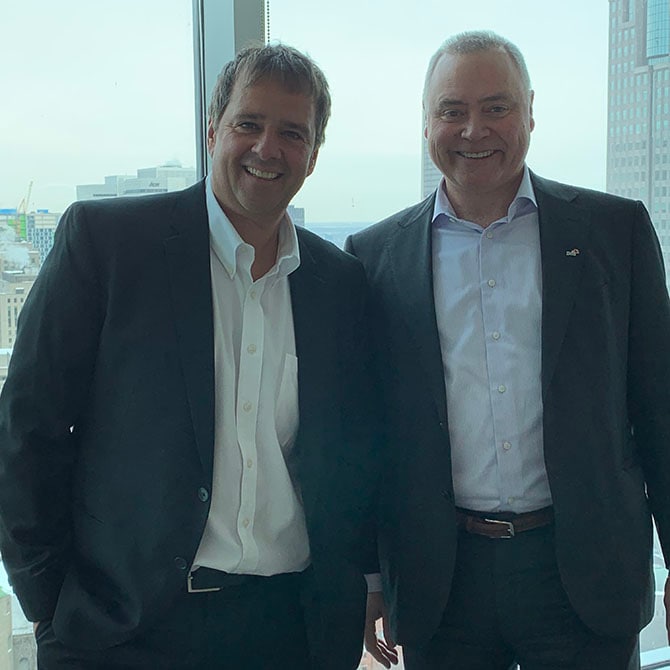Tax transformed case study
Creating value through tax
transformation at Bombardier

Restructuring, centralization and refocusing all part of long-running changes to create space for an expanded role in supporting the business.
Client: Bombardier Inc.
Services: Tax
Country: Canada
Introduction
With business units having had a limited view of the role of Bombardier Inc.’s tax function in the past, the company’s Vice-President of Taxation, Pierre Lafontaine, has been helping lead an ongoing transformation that has given his group a bigger seat at the table and created new efficiencies across the organization.
Challenge
With operations in more than 40 jurisdictions, Bombardier’s tax function has a complex job in helping the company comply with tax rules while delivering value and providing support and guidance to the business. But in the past, the business units the tax function served weren’t always aware of all of the ways it could support them and the value it could generate.
Many looked at the tax function as a group that helped with financial statements and tended not to include the tax function in broader business decisions. With tax implications arising in almost all areas of the business—including deals activities, reorganizations, customer and supplier contracts and human resources matters—the company faced missing out on an important source of advice.
In the meantime, the company has also undergone broader shifts, including leadership and workforce changes that have created a new drive to find efficiencies and transform how it operates.

“With the continuous transformation at Bombardier, we are dedicating fewer internal resources to our tax compliance, so the team can focus on more value-added activities, including business support. That means we are part of every deal, M&A transaction, contract and reorganization, etc., given that any tax issue or missed opportunity can represent several millions of dollars.
Approach
The tax function has played a significant role in participating in and supporting those shifts. The transformation began in 2005, at the initiation of the tax function itself. Seeing the tax function on the sidelines of important business decisions and activities, Lafontaine and his team moved to have it included from the outset. This meant organizing meetings and presentations to talk to the business units and other corporate functions about the tax function’s role and how it could be a helpful advisor to them.
Part of the goal was to emphasize that the tax function shares the same goals that they have: to improve the company’s financial performance in a way that delivers benefits for everyone. The transformation also included centralizing the tax function, which represented a significant shift from the previous structure in which those working in tax reported to the various business units.
Over the years, a workforce reduction, from 46 to 35 tax specialists, led to further transformation changes. In the drive to find efficiencies, Bombardier began centralizing more work internally among shared-services organizations. Those changes followed moves to outsource some of its tax compliance tasks a few years earlier.
An evolving transformation
Bombardier’s tax transformation has evolved over time, with changes implemented in different phases as Lafontaine and his team looked at the impacts of their actions and what else they could do to better serve the business units. Key elements of the transformation, starting in 2005 and continuing today, include:
- Centralize the tax function across Bombardier, including those previously attached to specific business units or jurisdictions, to operate as one group.
- Centralize certain aspects of tax work, like compliance and transfer pricing documentation.
- Develop and implement a corporate tax policy to emphasize to business units and corporate functions the importance of communication with the tax team to make sure their decisions and activities take the tax implications into consideration.
- Look at best practices at top organizations around responsibilities and objectives of the tax function.
- Automate various tax processes. In Canada, for example, it has automated (or is in the process of automating) accrual-to-return processes and country-by-country reports. It has also automated certain tax forms in Canada and the United States, including some of its processes related to tax incentives for research-and-development activities.
Impact
By consolidating and standardizing its tax function, Bombardier was able to continue meeting its global compliance requirements while supporting and improving the organization from a tax standpoint.
The transformation has helped to create space for the tax function to focus on more value-added aspects of its role, while being fully compliant with applicable tax laws. It’s all part of achieving the tax function’s goal of operational excellence and acting as a reliable internal advisor to the business.
But the transformation work isn’t over. With Lafontaine’s department planning further changes, the tax function is working to generate more value and deliver efficiencies that will increase its impact even more. As his group has shown, tax transformation isn’t a one-off event. By building on each success, tax functions have an opportunity to continually add to the value they bring to the business and make sure they’re delivering to their full potential.
Learn more on how to enable tax transformation



















